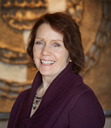Molly Larkin's Blog, page 16
October 8, 2014
Christopher Columbus — First Illegal Alien

This post first appeared on this blog in October 2013. I will repeat it every “Columbus Day” until this holiday is nationally changed to Indigenous People’s Day, following the lead of Berkeley, California, Seattle, Washington and Minneapolis, Minnesota. I do not believe we should be celebrating a murderer and slave trader.
 Imagine a foreign-speaking stranger walked into your house one day, claimed it was now his and threw you out, or even enslaved or killed you and your family.
Imagine a foreign-speaking stranger walked into your house one day, claimed it was now his and threw you out, or even enslaved or killed you and your family.
Would you celebrate him with a national holiday?
Neither would I.
Yet the United States and other countries in the West continue to celebrate Christopher Columbus as having discovered the “New World” even though there was a perfectly marvelous civilization already living here.
[Columbus Day in 2014 is Monday, October 13 – a Federal holiday.]
My Lakota dad Wallace Black Elk called Columbus “the first illegal alien.”
Native Americans had been living fulfilling lives on this continent for thousands of years before Columbus’ arrival. Or, as author Kurt Vonnegut put it, “1492 was simply the year sea pirates began to rob, cheat and kill them.”
Schools today are finally teaching children that Columbus and his men enslaved native inhabitants of the West Indies when they first arrived. That’s a step in the right direction because when I was in school, I wasn’t taught that truth.
So why do we still celebrate him?
The events of 1492 and beyond
The voyage during which Columbus stumbled upon North America was actually a commercial expedition. Because the spice trade had become expensive by having to transport over land, he was seeking a water route to the Far East.
As we all know from our school days, Columbus was financed by King Ferdinand and Queen Isabella of Spain and set off in three ships: the Nina, Pinta and Santa Maria.
After a month, Columbus and his crew were frustrated and ready to turn around when they suddenly saw land: an island in the Bahamas. Columbus thought he was in the East Indies and called the inhabitants Indians.
However, another version of the origin of the name “Indian” is that Columbus recognized that these people were “of God” – in Dios. Which became “Indian.”
He recognized their gentle nature: in a letter to one of his patrons, he wrote:
“They are artless and generous with what they have, to such a degree as no one would believe but him who had seen it. Of anything they have, if it be asked for, they never say no, but do rather invite the person to accept it, and show as much lovingness as though they would give their hearts.”
Right after making that observation, Columbus offered to send back as many slaves as requested.
Columbus wrote in his journal: “with fifty men they can all be subjugated and made to do what is required of them.”
After his second voyage, Columbus returned to Spain taking gold, parrots and Native American slaves.
By 1514, the Spanish conquerors gave an ultimatum that the Natives must convert to Christianity or be enslaved and “we shall take away your goods, and shall do all the harm and damage that we can.”
Columbus made three more trips to the “new world” but felt like a failure for not having found the new shipping route for spices he’d been seeking.
Legend has it that he died in 1506 a disappointed man.
Brave? Yes
The first? No
Christopher Columbus was not the first European to arrive in North America
The Vikings were here 500 years before Columbus. According to historical documents now confirmed by archeological findings, Vikings sailed across the Atlantic and reached the northeast coast of North America in 1000 AD. There are remains of an early 11th Century Norse village in Newfoundland.
The Irish Monk St. Brendan the Navigator reached North America in the 6th Century. The account of his journey was published some 300 years later in Navigatio Sancti Brendani [Travels of St Brendan].
But these early explorers were polite, and left only footprints and took only memories, to paraphrase a famous instruction for visiting new land.
If Columbus had the same sensibilities as the Vikings and St. Brendan, the world would likely be a very different place today.
Once again, I invite you to share with your children the true history of Native Americans in this country.
Sources: http://www.understandingprejudice.org...
Hanke, L. (1949). The Spanish struggle for justice in the conquest of America. Philadelphia, PA: University of Pennsylvania Press.
October 1, 2014
Do you know where you come from?
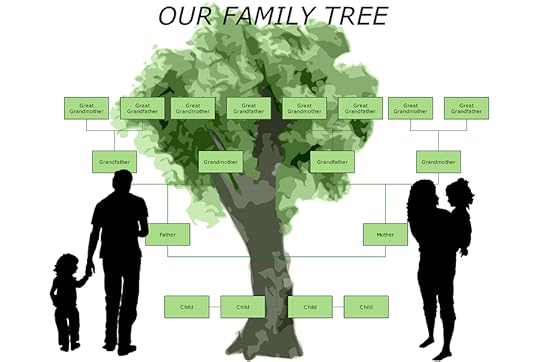
 Do you know where you come from?
Do you know where you come from?
I’m not talking geography here, I’m talking about our ancestors – those who walked before us and paved the way for our life today.
Learning about your ancestors can give your life a whole new meaning.
Know your ancestors, know yourself
In 1992, I accompanied a Native American elder to Australia for a conference including Maori and Aborigine elders.
Maoris are the indigenous Polynesian people of New Zealand, but the group traveling with us was living in Australia at the time.
Known for their warrior culture, Maoris are also known for their traditional haka war dance. If you’ve ever watched New Zealand’s rugby team, the All-Blacks, you’ve likely seen them perform the haka before the game. It’s meant to intimidate their opponents and raise their own energy and is quite a sight to behold and feel. You can find quite a few videos of it on YouTube.
But Maoris are also very friendly and fun loving and loved to sit around camp singing and inviting people over for coffee and laughter.
Because they were living in Australia at the time, the Maori family invited our group to come and stay at their home in Adelaide for a few days in between teaching events. It was here that I got the most powerful life lesson of that trip.
When we arrived at their home in the Adelaide suburbs, we were asked to wait outside until it was time to be led in by one of their daughters.
Not long after our arrival, the eldest daughter appeared on the front porch, and chanted to us three times in a loud, moving voice: “Haraymara, Haraymara, Haraymara.”
The daughter standing on the sidewalk with our group responded by calling out, “Karanga Mai, Karanga Mai, Karanga Mai.”
Then we were led inside for a welcoming ceremony.
Later that day, I asked about the meaning of the chanting in the front of the house before we came in.
I was told that the eldest daughter was calling out an invitation to our ancestors who always walk before us.
And the younger daughter replied on the ancestor’s behalf: “We are coming, and we are bringing them with us.”
That teaching profoundly moved me: that our ancestors are always paving the way for us, and surrounding and protecting us. It is a common teaching of indigenous peoples; one that has, unfortunately, been lost in western culture.
Where do you come from?
At a Celtic funeral, the deceased’s lineage is recited – because the Celts understand that where you come from is part of who you are.
In early Celtic times, people sought advice by ritually sleeping on the graves of their ancestors in the hope of meeting them in their dreams.
Knowing who came before us is an important part of knowing ourselves. In a Time Magazine about lineage, the writer quoted an Afghani man who could trace back his ancestors 19 generations.
Native American’s often introduce themselves by reciting their lineage, such as what clans their mother and father were part of.
For example, this is how I’ve introduced myself in ceremonial situations where a full introduction was called for:
“I’m Molly Larkin, born to John and Iva, descended from the O’Donohue’s of Bantry, County Cork, Ireland, the Larkins of Laragh, County Cavan, the McCallions of Ballymeana, Northern Ireland and the McLane’s of Cork City, Ireland. Daughter to Wallace Black Elk of the Lakota Nation and Bear Heart of the Muskogee Creek. I’m also known as Nokos-fe-ko che [Little Bear] of the Bear Clan of the Muskogee Creek Tribe of Oklahoma.”
In the indigenous world, that is the only way for someone to truly understand who I am.
What’s in your DNA?
There is scientific evidence that genetic memories can be passed down through our DNA.
So we carry our ancestors’ DNA in our own; they are a part of us, just as our descendents will carry a part of us, too.
Here’s how to truly learn where you come from:
ONE: Learn who your ancestors were, where they came from. Learn about your culture of origin.
Many times before they passed on, I sat down with my parents and a tape recorder and interviewed them about their childhood and families.
If you live in the United States, unless you’re 100% Native American, you had ancestors who came from another country looking for a better life for themselves and those who would come after them.
What are some of the sacrifices your ancestors made to come over here?
How does awareness of your ancestors define who you are today?
Who in your family of origin had the most spiritual impact on your life? And why?
TWO: Carry on what they started. Did they have a favorite cause that you can continue supporting?
My grandfather was an orphan who had the opportunity to go to the New York Times Summer Camp when he was a child. When he grew up and became a successful self-made businessman, he donated to the N.Y. Times Summer Camp fund every year so that other children could benefit as he had as a child.
When I learned that, I started donating to the fund as a way of honoring my grandfather and keeping his legacy alive.
What can you do along the same lines?
THREE: Call upon your ancestors for guidance. Ask how they would have handled a problem.
One way to do this is to ask a question before you go to sleep and see what information comes to you upon waking.
If they were not admirable people, ask what would have been a better way to behave. Learn to distinguish what wouldn’t apply to your life.
Some Biblical scholars say that the reason Moses wandered in the desert for 40 years was for the oldest generation and their limiting beliefs to die off. Not everyone is wise and admirable; learn to be discerning.
FOUR: As an ancestor to future generations, what is the most important thing you wish them to inherit from you?
What have you learned that you want to pass on to the next generation?
What are your hopes for your descendents?
What will help them soar?
What is the best thing your ancestors taught you that you could pass on?
Embrace the part of your ancestors’ legacy that were good and wholesome and categorically reject the rest.
We have the ability to go inside ourselves and learn from the ancestors.
They’re waiting for us to call on them.
Honor them that way.
You’re the reason they existed in the first place.
“You may not remember, but let me tell you this: someone, in some future time, will think of us.” Sappho, 7th Century B.C. poet, composer, musician, teacher, priestess of Aphrodite.
“When somebody dies, the spirit of that person lives on. Spirits can go and come from that place where the Creator lives. It’s easier for them to go back and forth as long as somebody remembers them.” Leon Shenandoah
September 26, 2014
Is the invisible world the real world?

 How many do you see when you look at this picture?
How many do you see when you look at this picture?
In most of my classes I hold up my hand and ask this question: “How many do you see?”
I always get one of two answers: “five fingers” or “one hand.”
But a traditional Native American might say, “nine,” because they count the spaces in between.
To them, the invisible world is as real as the visible. And it’s the invisible world we want to connect with in order to maintain the magic in life.
What’s in the invisible world?
What we cannot see is usually depicted in Western society as the stuff of horror stories or science fiction, but that doesn’t necessarily have anything to do with reality.
And, yes, the invisible world is real.
A scientist would answer that it’s full of “energy.” And that would be correct.
But what I’m talking about is the spiritual realm which is full of energy, spirits, ancestors . . . and answers.
Some call them spirit guides. Others call them angels. Native Americans might refer to them as ancestors. To me, they’re all of that.
Regardless of the name, the world we cannot see is full of life.
This is the place where intuition reigns, where our emotions connect us to one another.
There’s so much we don’t yet understand about how the world works – and the answers lie in the invisible world which traditional Native American’s have long understood.
A look at the visible world
It’s so very easy to think this material world is all that there is:
get up,
eat,
go to work,
eat,
come home,
eat,
watch TV,
go to sleep,
Buy stuff in between,
Repeat.
That’s the limited life of a limited mind. When we understand our true power, which traditional indigenous people always have, then the daily grind described above becomes:
Wake up each morning to the miracle of a sunrise. And at night the sun goes to sleep, too. How awesome is that?
Eat amazing, nutritious food from Mother Earth that we can actually grow ourselves, if we so choose.
And if we follow our passion, we get to do work which not only allows us to meet our obligations, but also inspires and fulfills us and adds value to the planet.
At night, the amazing invention of the television can entertain and educate.
And then we get to do it all again the next day, with some variation thrown in whenever we wish.
We can travel to far off places by flying in amazing ships that sail the skies!
We can talk to people anywhere in the world using the miracle that fits in the palm of our hands. [I’m talking smart phones here].
We are in charge of our own lives; we are always at choice.
And then there’s fine tuning accomplished through other things that are invisible.
The invisible world
The invisible world includes:
Creating our own reality through using visualization and goal setting.
Healing ourselves and others.
Communicating
Learning to be happy with fewer material possessions.
Practicing forgiveness — the key to a healed life.
Connecting with nature on a daily basis.
Connecting to the divine through prayer and meditation.
Practicing compassion and kindness.
Loving other human beings and animals.
When asked by Oprah Winfrey what happens when we die, Eckhart Tolle replied that the essence of who we are is indestructible. When someone dies, the essence of that being merely inhabited that form – the life within the form was always invisible.
And that invisible life is what’s in between the spaces.
My first Native American teacher, Sun Bear, taught that there are beneficial spirits on every square inch of Mother Earth, just waiting to help us.
These spirits would be mostly people who used to live in a physical body but are now in the spiritual realm, in their indestructible spirit form. Native Americans call them “ancestors.”
Westerners might call them “angels.”
Whatever you call them, they are good and want to help us when we ask.
How many times have you called upon a deceased relative for guidance or help? Sometimes we can feel the presence of those relatives, watching over us and still loving us.
Next week I’ll write more about the indigenous teachings about ancestors and what we can learn from them.
So, is the invisible world the real world? Hard to say, but I think it’s what makes the visible world worth living in.
In the meanwhile, remember that,
“We are not human beings having a spiritual experience. We are spiritual beings having a human experience.” Pierre Teilhard de Chardin
September 18, 2014
Native American spirituality – three myths laid to rest
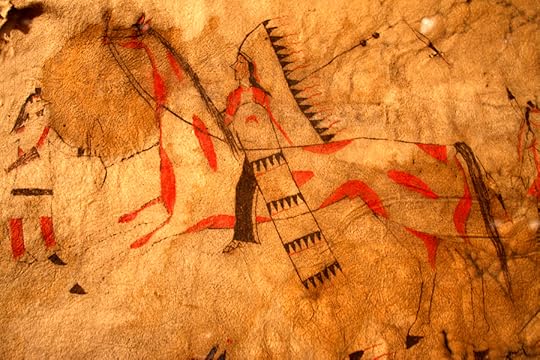
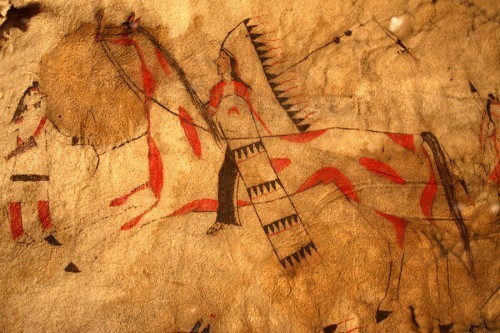 In my years of “walking the red road” as well as well as living in the non-Indian world, I’ve come across a few misconceptions about Native American spirituality that I’d like to lay to rest.
In my years of “walking the red road” as well as well as living in the non-Indian world, I’ve come across a few misconceptions about Native American spirituality that I’d like to lay to rest.
Here are the most common misconceptions I’ve heard:
Native Americans idolize things such as bison [buffalo] skulls and nature.
Native Americans don’t believe in God.
Native Americans believe in ghosts.
None of the above is true. Here’s what is true as to what Native Americans believe in:
One: Respecting, appreciating and protecting all life
That includes the natural world and animals. And not just four legged animals, but
two-legged [humans],
wingeds [birds],
swimmers [fish],
creepy crawlers [insects],
the tall standing brothers [trees] and
the green nation [everything else on earth].
While a bison skull may be seen in Native American ceremonies, it is not being worshipped any more than the statues of the saints in a church are worshipped.
Skulls and statues are merely reminders.
The bison skull serves to remind the people that the bison of old was a gift from the Creator which gave Native Americans everything they needed in order to live:
meat to eat;
hides which covered their tipis;
bones which made tools;
sinew was used as thread to make the clothes and coverings;
the extra thick hide on the top of the head became a bowl;
Horns were made into spoons;
The heart was used as an instrument for carrying dried meat;
The stomach became a cooking vessel.
Every part of the bison was used.
This was the reason for the U.S. Government’s campaign to eradicate the bison in the 1800s. Mass slaughter of bison essentially took away the plains Indians’ source of life and, in the words of Gen. Philip Sheridan, “settled the vexed Indian question.”
Prior to the arrival of the Europeans on North America it is estimated there were 50 million bison roaming the western ranges.
By the 1890s they were nearly extinct.
Today the estimate of bison in North America is up to 500,000, thanks to dedicated breeding programs by Native Americans and others.
Two: There is only one God
Borrowing the Rose analogy, God by any other name [Creator, Great Spirit, Higher Power, whatever you want to call him/her] is still the same.
Just because Native peoples call the Great Spirit by a different name than Christians do doesn’t mean it’s not the same God that Christians pray to.
Just because people in Spain speak Spanish and not English doesn’t mean they can’t communicate. A different language is simply a means of communication under another name.
Lack of understanding and respect for other ways of functioning in the world is one of the biggest causes of the tragedies going on today. We all need to learn respect for different ways of seeing the world.
American actor Matt Damon, citing the fact that, as of 2008, only 20% of U.S. citizens had passports, suggested Americans should travel more to better understand global problems. He said, “I think many of our problems as a country would be solved if people had thick passports.”
Fortunately, as of January 2014, the percentage of U.S. passport holders is now up to 46%.
But still, the majority of U.S. citizens have never left the United States.
I find that a shame, as international traveling has broadened my perspective perhaps more than anything else I’ve ever done.
Three: Native Americans do not believe in “ghosts.”
What are ghosts anyway?
A Google search brought up this definition: “an apparition of a dead person that is believed to appear or become manifest to the living, typically as a nebulous image.”
By that definition, Native American do not believe in ghosts.
However, there is an invisible world we cannot see. One that is full of energy, spirits, ancestors . . . and answers.
Some call them spirit guides. Others call them angels. Native Americans might refer to them as ancestors.
Regardless of the name, the world we cannot see is full of life.
I’ll write more about this in next week’s post.
So just because someone does something differently than we do doesn’t make them weird, or wrong.
Seeking to understand the “why” before making judgment is the hallmark of an enlightened person.
And we are all capable of that.
September 10, 2014
On snakes, transformation and “crushing it”
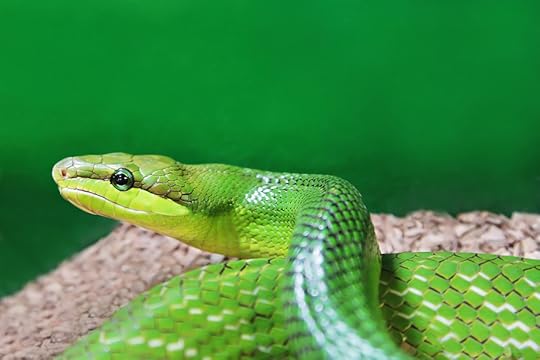
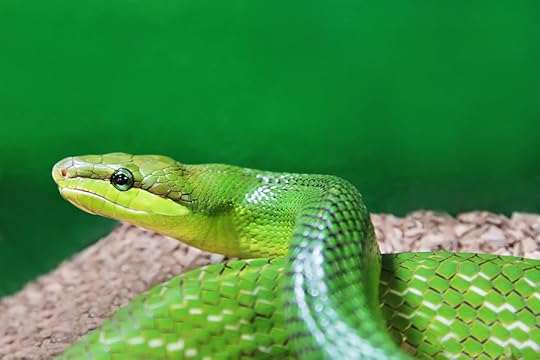 Upon finding a road-killed snake last week, “crushing it” took on a whole new meaning for me.
Upon finding a road-killed snake last week, “crushing it” took on a whole new meaning for me.
According to urbandictionary.com “crushing it” means: “Being in severe shape, looking good, being better than others, looking hot, feeling positive, having more than others, having relations with other attractive people.”
Or put another way, “doing it all…. well.”
But can we really “crush it” in everything we do?
Not according to television screenwriter/producer Shonda Rhimes in her June 2014 Dartmouth Commencement Speech. Ms. Rhimes is the creative force behind the hit TV series Grey’s Anatomy, Private Practice and Scandal and had this to say:
“As a very successful woman, a single mother of three, who constantly gets asked the question, ‘How do you do it all?’ For once I am going to answer that question with 100 percent honesty here for you now.
“Shonda, how do you do it all?
“The answer is this: I don’t.
“Whenever you see me somewhere succeeding in one area of my life, that almost certainly means I am failing in another area of my life…
“Anyone who tells you they are doing it all perfectly is a liar .”
I love her honest answer, and this is why I want to take a look at how we really “crush it.”
Crushing it and snakes
I was riding my bicycle out of my driveway last week and came upon a beautiful green snake that had been run over.
Crushed.
Dead.
Flat as a pancake.
I offered tobacco to pray for its passing, and got a shovel to move it off into the meadow for a proper burial.
Then I thought about what it might mean. What message did it bring to me?
Road killed snakes are a rarity around here.
When unusual animal encounters take place in my life, I pay attention, as we all should, because there could be a message in it for us.
Snakes represent transformation. The shedding of their skin represents rebirth and healing.
That’s why the Rod of Asclepius, entwined with a serpent, has always represented the healing profession. Asclepius was the Greek God of medicine.
If transformation is about to take place in our lives, do we sometimes try to stop it?
Crush it?
Nip it in the bud?
Shonda Rhimes says we can’t do it all, and she should know. When we’re doing really well in one area of our lives, we are likely neglecting another area.
In other words, crushing it in the negative sense: stopping progress. And perhaps those are the areas we should be paying the most attention to.
I “crushed it” in my former high-pressure job in Los Angeles, but at the sacrifice of my health and spiritual and emotional lives. They were crushed in the negative sense until I was force to make a change.
Yes, change and transformation can be uncomfortable, but the brave thing to do is embrace it because the life you’ll be living at the end of the transformation may be much more beautiful than the one you’re living now.
“Before a snake begins to shed its skin, its eyes will begin to cloud over. It gives the snake a trancelike appearance. To many mystics and shamans this indicated the ability of the snake to move between the realms of the living and the dead, of crossing over from life to death and then back to life again. As the skin begins to shed, the eyes begin to clear as if they will see the world anew.” Animal-Speak: The Spiritual & Magical Powers of Creatures Great & Small
In order to shed it’s skin, a snake slithers into a very tight space so that it’s essentially stuck there, and the only way out is to resolutely move forward, leaving the old skin behind.
Do you need to make changes in your life but are resisting them?
What needs to be healed that you are holding on to?
Watch for signs and answers, particularly from the animal world.
Even if we don’t get an unexpected message, as I did from the snake, we can go looking for answers.
Put out a question and go for a walk, carefully observing the world around you. If you are open, answers will come.
Our guides and angels always want to help us. All too often, we tune them out.
In these trying times, I suggest we all work harder to tune into them.
And celebrate our transformation!
“What the caterpillar calls the end of the world, the master calls a butterfly.” Richard Bach
September 3, 2014
How do we teach children?

By example, our words and our actions. That seems pretty obvious.
But how do we do it well?
If we are living our best possible lives, we will teach by example and the teaching becomes easy.
I found a great example of it in my own family during a recent visit.
A few weeks ago, I walked into my kitchen and discovered my three-year old grand-nephew standing in front of the open refrigerator precariously holding my great-grandmother’s antique glass serving bowl with just one hand.
The bowl was full of fruit and fruit was what he wanted.
Two thoughts raced through my mind simultaneously: “please don’t drop that” and “wow, three years old and he’s choosing fruit as a snack!”
I made every effort to stay calm because I didn’t for one moment want him to think he’d done something wrong by choosing fruit.
I was delighted, and gently said, “let me help you” and took the delicate bowl from his hands and helped him to a serving of fruit.
My hat goes off to my niece and her husband: healthy vegetarians, who have passed good food choices on to their son.
How Indigenous people teach children
Children only know what we teach them. And we need to teach them well because they are the future of our country, planet and species.
Among indigenous people, raising children is the highest calling, for exactly the reason I just gave – they are our future.
Ironically, this is the reason all my Native American teachers have been men. Women stay home to raise the family, and it’s only when the children are grown and the mothers have become elders that those mothers might travel and teach.
“By using ideas like stewardship, good medicine, the Vision Quest and giving your child a spiritual name, parents will raise children who are innovators, not imitators—kids who grow into adults who are centered in themselves, live in harmony with nature, make lasting contributions to society and actualize their full potential, fulfilling their destiny here on Earth.” Laura Ramirez in Keepers of the Children: Native American Wisdom and Parenting
Raising children was also taken on by the entire extended family: aunties, uncles and grandparents shared child-rearing with the parents.
In 1993 I accompanied a Native American elder to Australia to attend a gathering of Native Americans, Maoris from New Zealand and Aborigines from Australia.
The Maoris traveling with us were a family of three generations; over twenty in all.
Maoris are so family-centered that they always travel together as one unit. And while the elders were offered a plane flight to Central Australia, they wouldn’t travel separately from the rest of the family, so they all drove together from their home in Adelaide – a ten hour drive!
I spent a lot of time with the Maoris during that trip and, in spite of my best efforts, I simply could not tell who were the birth parents of the little ones. All the adults cared for the children, and the children minded all of the adults.
The Maori grandmother told me, “We don’t teach our young. They just watch and listen.”
I ended up asking them to draw me a family tree so my logical western mind could understand the family relationships.
But to them, they were all just one big, happy family and that’s all that mattered.
Perhaps if other societies took more interest in guiding all children in a good way, the world would be in a better place.
My Chippewa-Ojibway teacher, Sun Bear, used to say, “People ask my for my opinion of abortion. But to me the more important question to address is: why have we created a nation in which a woman feels she doesn’t have the support she needs to raise a child? That’s what needs to be addressed.”
Thought-provoking.
If we adopted the Native way of teaching our children and supporting mothers, the world could be a better place.
If you have a child in your life, whether yours by birth, a relative or a neighbor, do what you can to guide and love them. Be an example of the good in the world.
Our future depends on it.
August 27, 2014
“We” versus “I” — Which do you say the most?
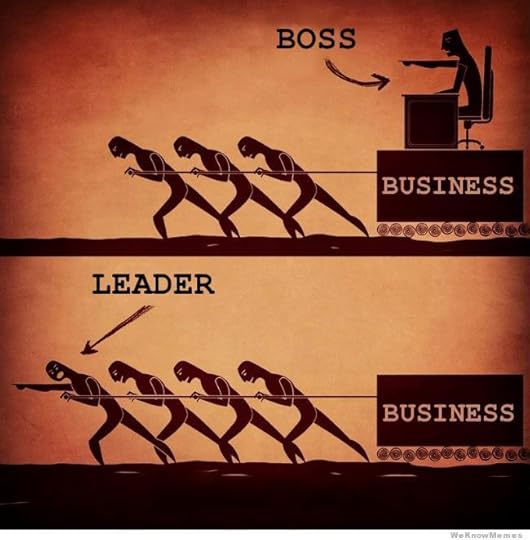
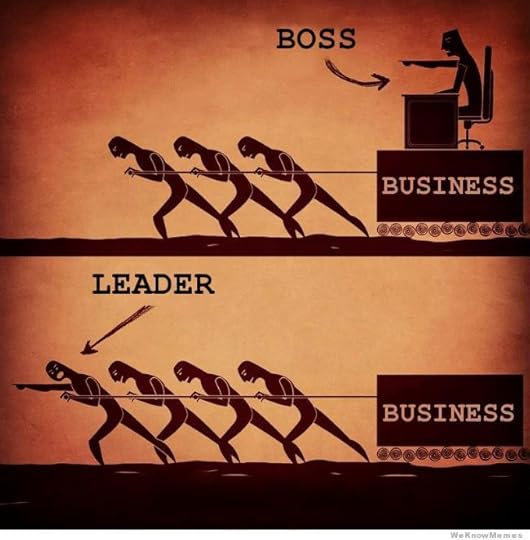 “We” versus “I” – which you say the most may determine your success in life.
“We” versus “I” – which you say the most may determine your success in life.
As a Keith Urban fan, I make a point of listening to interviews with him. Something caught my attention earlier this year when he was being interviewed about his duet with Miranda Lambert on their hit song, “When We Were Us.”
Urban said “Miranda used to open for us…”
Note that this megastar musician who is backed up by his own band said “us” not “me.” He considers his band as important in the equation of success as he is.
That’s class.
And it also shows a high consciousness.
“Us” and “we” consciousness is what makes the world go around in a good way.
“I” and “me” – not so much.
No successful person says “I”
Ernesto Sirolli in his September 2012 TED talk has this to say on the subject:
“Now we teach entrepreneurship to 16-year-olds in Northumberland, and we start the class by giving them the first two pages of [English business magnate Sir] Richard Branson’s autobiography.
“The task of the 16-year-olds is to underline, in the first two pages of Richard Branson’s autobiography how many times Richard uses the word “I” and how many times he uses the word “we.”
“Never the word “I,” and the word “we” 32 times. He wasn’t alone when he started.
“Nobody started a company alone. No one.”
While Mark Zuckerberg has become synonymous with Facebook, he readily acknowledges the team who surrounded him in its creation.
Just as Steve Jobs has become synonymous with Apple, the company was actually created by Jobs, Steve Wozniak and Ronald Wayne in 1976.
The “we” of the Mastermind Alliance
The concept of a “mastermind alliance” was made famous by Napoleon Hill in his classic book, Think and Grow Rich .
.
Hill came up with the idea after asking steel magnate Andrew Carnegie the secret of his success.
Carnegie replied that his success was due to the “sum total of the minds” of his business associates.
Carnegie was a Scottish immigrant who became the richest man in the world, yet he actually knew very little about steel – but he surrounded himself with the right people who did!
Hill defines it as: “The coordination of knowledge and effort of two or more people, who work toward a definite purpose, in the spirit of harmony…. No two minds ever come together without thereby creating a third, invisible intangible force, which may be likened to a third mind [the master mind].”
Mastermind Groups of successful people
Successful people throughout history have belonged to mastermind groups, which provides some key to their success:
Walt Disney and the “Nine Old Men” brought the world Snow White and the Seven Dwarfs, Peter Pan, Cinderella and many other Disney classics.
“The Inklings” was a group of successful writers including C.S. Lewis and J.R.R. Tolkein.
“The Junto” was a group of twelve created by Benjamin Franklin — they established the first U.S. lending library and the University of Pennsylvania.
“Sunday Night Supper” was a mastermind group including Averell Harriman which guided the U.S. through the Cold War.
Franklin Roosevelt’s “Brain Trust” helped shape the policies of the New Deal.
And on and on. Most people who we think of as successful individuals almost always relied on the advice and counsel of a group of trusted advisers.
Why it takes a village
“Individually we are one drop. Together, we are an ocean.” Ryunosuke Satoro
We live in a society where people, particularly women, have had to become fiercely independent and self-sufficient.
But the pendulum may have swung too far and that can become a mistake if we exclude the joy of community and sharing, and the magic that can happen with the synergy of creating something greater than the sum of its parts.
I live alone, and am very independent, but I’m also a member of a mastermind group to help me hold my vision and achieve my goals.
Who can you turn to for advice on what you want to achieve?
Look into Mastermind Groups. There are plenty of articles on the internet on how to start and conduct one.
And start paying attention to your language.
How often do you say “I”?
Try switching it to “we” and see what happens.
“People who work together will win, whether it be against complex football defenses, or the problems of modern society.” Vince Lombardi
August 20, 2014
Five questions that can change your life


There are five questions I suggest people ask themselves to steer their life in the right direction.
These are questions I’ve asked myself to bring about powerful change.
Questions are motivators: we can’t help but start working on an answer.
In fact, in studying copywriting, the writer is encouraged to phrase statements as questions– because people naturally want to know the answer! Humans are problem solvers at heart.
QUESTION ONE. “If you won the lottery and never had to worry about earning an income again, what would you do?”
This was a question asked of me by a career counselor many years ago. And the answer is a key to revealing what you should be doing with your life — even without winning the lottery.
There are many, many stories of people who won millions in the lottery and squandered it all on houses, cars, fast living and handouts to friends. I’m not going to go there, because if you’re reading this blog, you’re not the kind of person who would do that.
Hopefully, you would use the money to:
live a healthy lifestyle,
use your talents, and
contribute to the greater good of the world.
In fact, Native American’s taught that hoarding money and being excessively rich is a form of mental illness!
And when you don’t win the lottery…
There’s a lot of benefit from earning the money you live on. Years ago I had a friend who told me about her friend Anne, who dreamed of being a screenwriter.
Every time my friend went over to Anne’s tiny apartment, it was stacked with screenplays she was working on.
Anne’s most earnest project was a story about “a little kid who wanted to be a big kid.”
Anne’s brother was a big-time producer and director and my friend asked her why he didn’t help her out. Anne replied it was because her brother believed everyone should make it on their own.
Eventually, Anne Spielberg sold that script about the little kid who wanted to be a big kid and won an academy award for it – it became the hit 1988 movie “Big” starring Tom Hanks.
And the brother who believed everyone should earn their success is Steven Spielberg.
My friend has never forgiven Steven Spielberg for not helping his sister, but I’m inclined to agree with him.
The satisfaction of earning your success with no undue influence is very sweet. Anne Spielberg made it, she earned it, and no one can ever take that away from her.
Perhaps that’s why so many lottery winners essentially lose their minds and their money; they know they didn’t earn it and there’s a subtle guilt factor going on.
QUESTION TWO. “When you were five years old, what did you want to be when you grew up?”
For most people, the answer to this question is the key to why we’re in a physical body and what gifts we’ve been given to use.
At five years old, we’re still very in touch with our spirits, and our soul knows why we’re here on planet earth.
It’s the adults who talk us out of following our dreams. But I say: forget being sensible. Follow your heart.
I have always felt drawn to people who are still in touch with that inner child and the things they truly love.
After I graduated with a college degree that gave me no practical job skills, my mother paid my tuition to attend paralegal school. [I later learned it was because she hoped I’d “marry a nice young lawyer.” Sorry, Mom].
When I started working in the legal profession, I briefly flirted with the idea of going to law school but ultimately decided against it.
The reason is that I couldn’t imagine any of the lawyers I worked with as having ever been five years old. They’d lost their inner child, their joy for living, their innocence.
The exception is the attorneys I worked with for 17 years at my last job. But many of them didn’t even want to be lawyers any more, so ……
QUESTION THREE. “What would you do if you knew you could not fail?”
We’ve all heard that question before. But do we just move on without thinking about it?
Stop, think, what would you do?
Then find a way to do it.
Start out small. If you want to start exercising or improving your diet, make one small change, one day a week and gradually increase until you get comfortable with it.
QUESTION FOUR. “What am I grateful for?”
Research shows that people who ask this question every day tend to be happier, more successful and more likely to achieve their goals.
QUESTION FIVE. Every night ask, “What good have I done today?”
You’re going to want to have an answer to this question. So if you don’t, hopefully you will start living each day so that you do have an answer.
The bookend to that practice is the Native American morning prayer from The Wind Is My Mother :
:
“Creator, please help me to walk worthily today, so that when I lay down at night, I will not be ashamed.”
Giving, loving, being passionate about what you’re doing. These are the things that make life worth living.
And the answers were in you all along.
August 13, 2014
Did you ask the turtle?
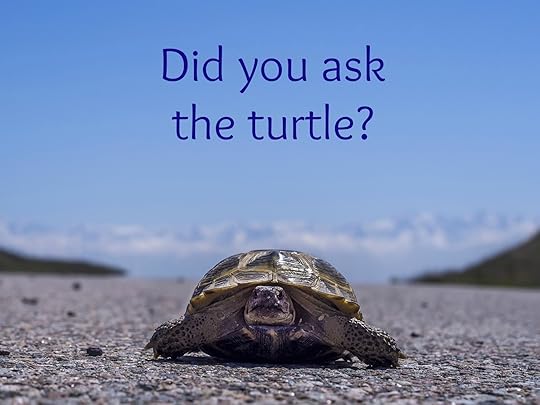

“Did you ask the turtle?”
That’s a question Gloria Steinham was asked in college after helping a turtle to the other side of the road.
It’s a cautionary tale about wanting to help people who don’t need our help.
That can be a hard lesson to learn.
Gloria Steinem, writer and leader of the women’s rights movement, gave a talk to Smith College alumni about lessons from her education, about how seemingly small incidents can have very big impacts.
At Smith, needing to fulfill her science course requirements, Ms. Steinem admitted she took a geology course because she considered it the least scientific of all the sciences.
While on a field trip in the wetlands of New England’s Connecticut River, she saw a giant turtle which had climbed out of the river, crossed a road and was in the mud of an embankment of another road, seemingly about to crawl up and get squashed by a car.
Gloria, fearing the turtle was going to cross the road and get run over, picked it up and carried it to the other side.
Her professor saw this and said, “Did you ask the turtle before you moved it? That turtle probably spent a week crawling up that dirt road to lay its eggs in the mud by the side of the road, and you just put it back in the river.”
So the lesson was, “Always ask the turtle.”
Or put another way, always ask those you want to help what it is they actually need and want.
This turtle story was told to me by a Smith College graduate who attended Ms. Steinem’s lecture. My friend had just organized a dinner party for someone who was visiting her only to find out that friend didn’t want a dinner party in her honor.
Live and learn.
Because you never asked
In his popular TED talk, Ernesto Sirolli tells the story of a group of Italians going to Zambia in the 1970s with seeds to teach the Zambian people how to grow Italian tomatoes and zucchini in their magnificent rich soil.
The Italians couldn’t understand why the Zambians didn’t have any agriculture in such a fertile area. Yet the Zambians showed no interest in learning how to farm.
Sirolli thought, “Thank God we’re here. Just in time to save the Zambian people from starvation.”
The tomatoes grew beautifully in that valley and, just when they were ripe and red, overnight, some 200 hippos came out from the river and ate everything!
And the Zambians pointed out, “That’s why we have no agriculture here.”
“Why didn’t you tell us?
“You never asked.”
What not to donate after a disaster
One of my favorite films is “Starman,” in which Jeff Bridges played an alien visiting earth. Just before he returned home, he said, “What I admire most about earth people is that, when things are at their worst, you are at your best.”
Nowhere is this truer than when there has been a natural disaster and we want to do something to help.
From the goodness of our hearts, we all feel compelled to take action when we learn of earthquakes, tsunamis, fires and floods. Gathering items to ship is literally taking action, and somehow seems more fulfilling than sending money.
Food and clothing drives make the givers feel good but are seldom what’s needed and may actually get in the way and hinder professional disaster efforts.
Many of these good-hearted donations sent to the disaster sites are what professional relief workers call the “disaster after the disaster.”
For example, used clothing would first have to be sorted and cleaned and relief workers don’t have time to do that.
When truck drivers after Hurricane Andrew couldn’t find organizations or warehouses to take the clothes, they left them on the side of the road where they rotted in rainstorms and summer heat and blocked the roads.
A better idea would be for the original senders to sell the clothes at a yard sale and send the proceeds to disaster relief organizations.
One estimate is that 60% of the donations to a disaster site are not needed. And unloading and storing or disposing of unnecessary donations can take away from more important relief efforts.
In most cases, the best donation is cash. Let the professional rescue organizations use it to bring in the supplies they know are needed, in an organized manner.
So that’s a great lesson that turtle brings us. She might have wanted to stay in the road or turn around – whatever.
That was her choice.
So always ask the turtle before you step in. Everyone may be the better for it.
August 6, 2014
Why you should never think about your age


Never think about your age! I learned that from a horse.
When I started riding lessons as an adult, the horse I rode most often was a Quarterhorse gelding by the name of Bug.
Bug and I got along quite well together and, as a result, my teacher usually paired me with him.
He was big, gentle and responded well to everything I asked him to do. Of course, as a beginning rider, I didn’t ask that much of him.
But I was still quite surprised when a few months into our relationship, I found out that Bug was 30 years old. That’s pretty old in horse years.
When I expressed my amazement to my riding teacher, she responded, “Well, the thing is, Bug doesn’t know he’s 30.”
What others think of your age is none of your business
So much of our self-perception is based on what others think we should be, do or have at whatever our chronological age is. That can be a lot of pressure.
For many years I refused to tell my age because I didn’t want people’s belief systems telling me I was a failure because I hadn’t achieved certain milestones by whatever age I was.
You’re as old as you feel. Period.
These days I don’t mind telling people my age because I enjoy the looks of surprise I get because I look much younger than my chronological years. [I’m 67].
Yes, I still color my hair, because I’ve vowed I won’t go grey until Bonnie Raitt does.
But I’ve never had “work” done. I’m vegan, exercise every day and live a healthy lifestyle– and all that belies my years.
If a problem starts to manifest, I nip it in the bud.
For example, arthritis in the knees? Here are the solutions:
Yoga: research has shown that yoga improves joint health and reduces the pain and stiffness associated with arthritis.
Glucosamine helps keep the cartilage in joints healthy. Natural glucosamine levels drop as we age and there is evidence that glucosamine sulfate supplements help counteract this effect.
Anti-inflammatory diet helps minimize arthritis pain. Foods to avoid include: fried and processed foods, sugars and refined carbs, dairy, alcohol and tobacco, processed table salt and preservatives, and corn oil. Foods to eat more of: fruits and vegetables. It’s not really a diet – it’s a lifestyle.
All the things my orthopedist told me I wouldn’t be able to do I am still able to do because of the above regimen.
As a healing practitioner, I’ve also done an enormous amount of work on healing my past emotional traumas. Continuing to carry them around also ages us. Get healing!
I refuse to let an arbitrary number slow me down. No one should.
Aging may be more cultural than biological
When Social Security was created in the U.S. in the 1930s, the legislation decreed 65 as the age of obsolescence.
That thought form still exists yet more and more people in their sixties, seventies and beyond are leading vibrant, healthy lives that contribute to the world around them.
How many stories have we heard of men being forced into retirement at 65 and dying a short time later because they felt their lives no longer held purpose? It’s just plain wrong.
Native American and other ancient cultures honor the elders, those who have lived and learned and can share their wisdom. Western culture does the opposite.
In some Native American nations, the equivalent of our Supreme Court is a counsel of women, led by the “oldest sensible woman.”
Our youth-obsessed culture, particularly here in the U.S., does a disservice to us all. It convinces otherwise intelligent people that they need plastic surgery and lipo-suction in order to feel valued.
In “Learning to Love Growing Old” on PsychologyToday.com, writer Jere Daniel says:
“The signs of denial and anxiety over aging permeate every aspect of our lives. We have no role models for growing old gracefully, only for postponing it. For example:
“The vast dependence on plastic surgery specifically to hide the visual signs of aging is arguably the sharpest index of our anxiety. In just two decades, from the 1960s to the 1980s, the number of . . . wrinkle-removing face-lifts rose from 60,000 to an estimated 2 million a year at an annual cost of $10 billion.
“The negative view of aging is disastrously reinforced by the media. Articles and advertising never show a mature model, even in displaying fashions designed for women over 50. A Newsweek cover of a sweating, gray-haired young man bears the cover line, “Oh God… I’m really turning 50.” Nursing home ads ask: “What shall we do about Mother?” By some sleight of mind, we not only come to accept these images, we come to expect them as truths.”
And I admit to falling for it, too. When I choose photos of people to accompany blog posts, I’m embarrassed to say I usually have gone for young 20-something women.
Two weeks ago I was searching for a photo to accompany my article on stretching. I almost went for a photo of a young woman, then I caught myself and said, “What in the world am I doing? Don’t buy into this.”
So I chose a photo of a vibrant, healthy grey haired woman doing yoga. You can see it at the top of this article today.
Whatever you believe is true
“If you believe it, it’s true. Period.”
This was said to me by an Arapaho elder many years ago. Nothing “new age” about that statement at all – it’s ancient wisdom.
Queens in the middle ages bought into the common belief that a woman couldn’t rule on her own and needed a husband to guide them. They believed it even though they were Queens! So they married.
The only exception was Elizabeth 1 who ruled England very successfully for 45 years without being married.
Many years ago, I was at a party and wandered into a room where friends were playing billiards. I had never played before so when asked if I wanted to join them, I said, “Sure, what do I do?” My friend told me which balls should go into which pockets and I picked up a cue and did just that!
My friends were stunned, but I was able to do it because I didn’t know it was supposed to be hard. I believed it must be easy so I just did what I was told!
Believe you’re young — because you are!
“Why do they say we’re over the hill? I don’t even know that that means and why it’s a bad thing. When I go hiking and I get over the hill, that means I’m past the hard part and there’s a snack in my future.” Ellen Degeneres, age 56


